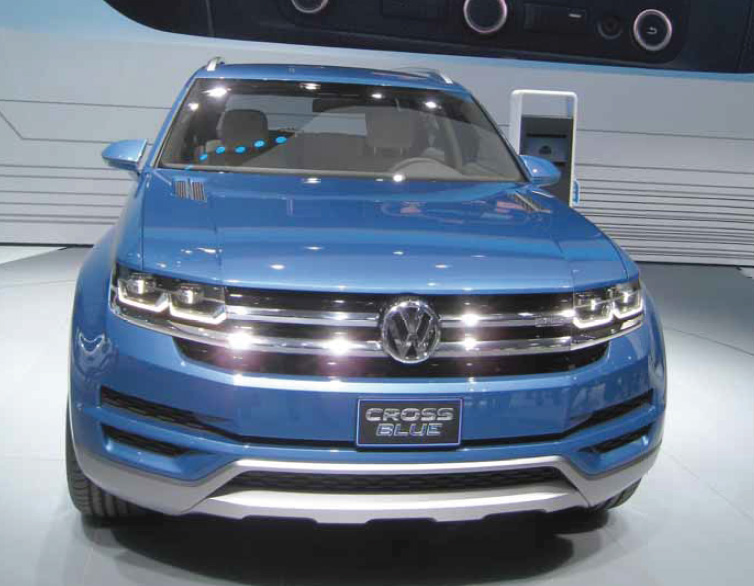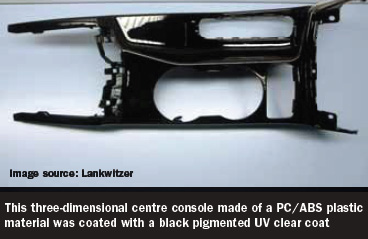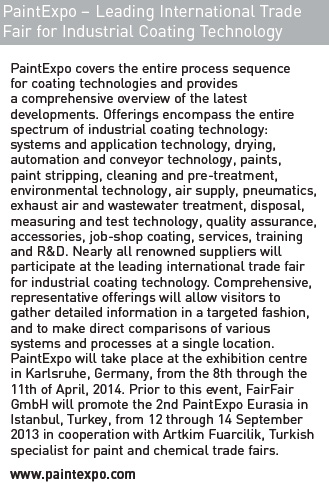
Whether it is the auto body, the interior or the optimisation of the qualitative properties of the paint, coating is one of the challenges faced by the automotive industry and its suppliers. On the one hand, this involves improving resistance to corrosion, as well as to other physical, chemical and mechanical stressing, to which the various vehicle components are subjected. On the other hand, emphasis is also placed upon enhanced optics and haptics, which can give more vehicle individualisation. Rising cost pressure due to global competition and demand for environmentally sound production are making it necessary to lay out the painting process in a more efficient, resource-efficient manner. A further aspect which influences the painting process is the increasing mix of metals used in auto bodies and components resulting from the growing use of lightweight construction strategies.
 More eco-friendly pre-treatment
More eco-friendly pre-treatment
Certain prejudices still prevail, in particular where the auto body is concerned, but the baths used to pre-treat auto bodies and metallic parts are more and more commonly “cold”. The reasons for the increasing popularity of nano-ceramic pretreatment processes, which can be implemented as immersion or spray procedures, are obvious: as opposed to conventional zinc phosphating, the heavy-metal-free alternative can be run at room temperature. This results in savings in the areas of energy consumption and emissions. Minimal expense for wastewater treatment and disposal, as well as system cleaning and maintenance, are a further advantage. And this pre-treatment technology has another ace up its sleeve in lightweight construction applications as well, because it is multi-metal compatible.
Eco-friendly alternatives are also available for the initial coat based on cathodic dip painting. These alternatives contain less the 1% solvent and are tin-free, which makes them compliant with future European legislation, as well as other existing regulations. Dip painting is distinguished by optimum coverage and good corrosion protection.
When auto bodies are transported through the pre-treatment and cathodic dip painting processes, shuttle systems with  freely programmable axes for advancing, lifting and rotary motion allow for precise matching of immersion curve and processing time to the respective body shape. This coordinated motion sequence also provides for a uniformly even coating, as well as fewer enclosures and less power input on bonded surfaces, thus assuring optimised quality.
freely programmable axes for advancing, lifting and rotary motion allow for precise matching of immersion curve and processing time to the respective body shape. This coordinated motion sequence also provides for a uniformly even coating, as well as fewer enclosures and less power input on bonded surfaces, thus assuring optimised quality.
Skid-free conveyor technology is becoming more widespread, not only in pre-treatment, but also in the actual coating process as well. This is not least due to the associated energy savings that result from the fact that heat lost in warming up the large skids in the oven is eliminated.
Material and application advantages
For paint processes with filler coats, as well as for so-called integrated systems, water-based paint systems are more ecofriendly than their solvent-borne counterparts despite higher energy consumption and thus higher CO2 emissions. This is due to their lower VOC emissions. In the case of conventional processes with filler coats, wet-on-wet application (by means of which the primer, the base coat and the clear coat are applied without intermediate drying) offers economic and ecological advantages. These include shorter production time, reduced energy consumption, shorter painting lines and lower emissions. These advantages are even more significant where integrated painting processes are involved. In this case, application of the filler coat is eliminated together with its associated baking step. This results in reductions in energy consumption and CO2 emissions of up to 20%. Last but not least, the entire filler coat section of the painting system becomes superfluous, along with its associated investments.For these reasons, integrated processes are becoming more and more popular, even for painting plastic parts.
 Minimising paint loss also offers potential for streamlining painting processes. Electrostatically assisted spray guns and high-speed rotary atomizers contribute to the achievement of application efficiency levels of more than 90%. Consequently, these systems are being used to a greater extent for interior auto body painting. This type of painting is frequently automated with the help of robots. In addition to reduced material consumption, robots also allow for better reproducibility of painting results and lower scrap rates, as well as easier changeover from fresh air exhaust to recirculating air systems. This, in turn, results in energy savings of between 60% and 70%.
Minimising paint loss also offers potential for streamlining painting processes. Electrostatically assisted spray guns and high-speed rotary atomizers contribute to the achievement of application efficiency levels of more than 90%. Consequently, these systems are being used to a greater extent for interior auto body painting. This type of painting is frequently automated with the help of robots. In addition to reduced material consumption, robots also allow for better reproducibility of painting results and lower scrap rates, as well as easier changeover from fresh air exhaust to recirculating air systems. This, in turn, results in energy savings of between 60% and 70%.
Research is currently being conducted on new application techniques, which are targeted at paint application with practically no overspray at all. The simulation of paint application also supports the minimisation of paint loss in this respect. However, until it is possible to apply paint without any overspray, the most efficient way to remove paint mist must be found. Electrostatic separator systems are one solution. As compared with conventional wet scrubbing, up to 75% of the required energy can be saved, and water consumption can be reduced by more than 85%.
Energy efficient drying
The industry is also working on energy efficient drying processes. Approaches include optimised air routing through sluice and tunnel areas, as well as optimised heating units and waste-heat utilisation systems. Energy on demand is another approach. This solution focuses on the adaptation of volumetric airflow and exhaust-air purification to zone-specific requirements. Potential energy savings can also be gained through the use of highly efficient air distribution nozzles. They make it possible to heat up thick-walled sections of the auto body more quickly, thus allowing for a shorter drying zone. In addition to saving thermal and electrical energy, overheating of thin-walled sections and deformation of components can also be avoided.
and tunnel areas, as well as optimised heating units and waste-heat utilisation systems. Energy on demand is another approach. This solution focuses on the adaptation of volumetric airflow and exhaust-air purification to zone-specific requirements. Potential energy savings can also be gained through the use of highly efficient air distribution nozzles. They make it possible to heat up thick-walled sections of the auto body more quickly, thus allowing for a shorter drying zone. In addition to saving thermal and electrical energy, overheating of thin-walled sections and deformation of components can also be avoided.
UV-tech – the forgotten magic?
UV paint systems make it possible to cure a layer of paint in just a few seconds. Amongst other advantages, the resultant paint layer is very hard, as well as highly resistant to scratching, abrasion and chemicals, after curing. However, coating and curing 3D components with these environmentally friendly paints has proven problematic thus far, for which reason they are used primarily for two-dimensional parts with simple shapes. The problems are caused by the fact that the paint is not fully cured until all of the component’s painted surfaces have received the required dose and intensity of UV light. In the meantime, solutions have nevertheless resulted from research projects, with the help of which three-dimensional metal and plastic parts can be reliably coated with UV paints. Application, flash-off and curing take place in an inert gas atmosphere with these solutions. The inert gas, for example CO2 or nitrogen, reduces oxygen content to a minimum, allowing adequate radiation energy to be absorbed by the parts. The paint is cured in just a few seconds solely by means of UV radiation, without any thermal process.
This procedure, which is extraordinarily short as compared with conventional drying, not only allows for very high production throughput speeds but the typical, long and energy-intensive dryers and downstream cooling zones become superfluous as well. This results in advantage with regard to floor space requirements, investment and operating costs, as well as energy consumption and CO2 emissions. Theoretically, it’s now even possible to coat and cure an entire auto body with a UV clear coat, but this is still associated with considerable expense.
Customisation and coating
The customer is increasingly sophisticated and demanding in all aspects of automotive products, and this is particularly true in coatings. The number of special paint finishes has greatly increased as a result. Among others, pearl effect paints are currently in fashion, which place greater demands on painting and paint delivery systems. In the case of clear coats for the high-gloss auto image, systems that offer increased resistance to scratching are at the top of the list. The paint industry offers developments to this end that combine the advantages of “hard” inorganic substances and “soft” organic substances, thus providing for a certain selfhealing effect.
Combination surfaces and plastic parts with chrome effect represent a further trend. Plastic components are chrome plated by means of either conventional electroplating or PVD coating. Conventional pigmented systems and UV-curing paints are available for protecting the metal layer after the coating process, and for providing it with an custom appearance. In the case of high quality interior components made of wood, plastic or metal, an innovative curtain coating system is offering new perspectives for reaction injection moulding (RIM). This modular paint system is based on 2-component, solvent-free, aliphatic polyurethanes which are processed in high pressure systems. Coating to a thickness of 0.1 to 2 mm is accomplished in a single process step.
The part to be painted is inserted into an oversized mould, and the remaining space is filled with paint. Depending on part geometry and material type, coating and cross-linking take two to three minutes. The part can then be removed from the mould and further processing is possible after roughly 24 hours, although no sanding or other smoothing is necessary. In contrast to multi-coat painting, this process not only offers time savings, it’s also highly efficient thanks to minimal material loss. The surface fulfils many demands of the industry, and is distinguished by good resistance to heat and UV radiation. Surfaces with better scratch resistance and a selfhealing effect can also be produced in this way.
If the surface is scratched, the paint system’s self-healing function becomes active at room temperature, or it can be triggered by applying a minimal amount of heat. Second to the coating of interior parts, many current developments are focused on exterior use in piano black.



































